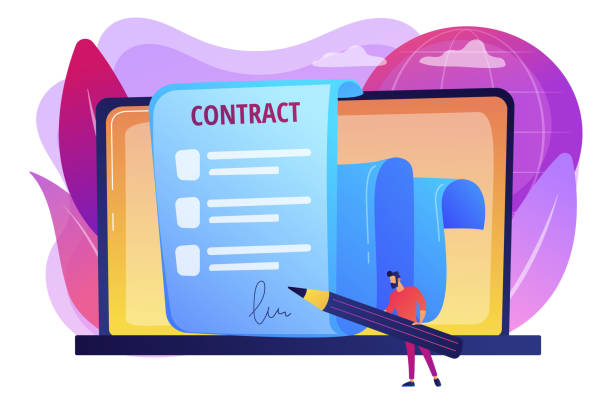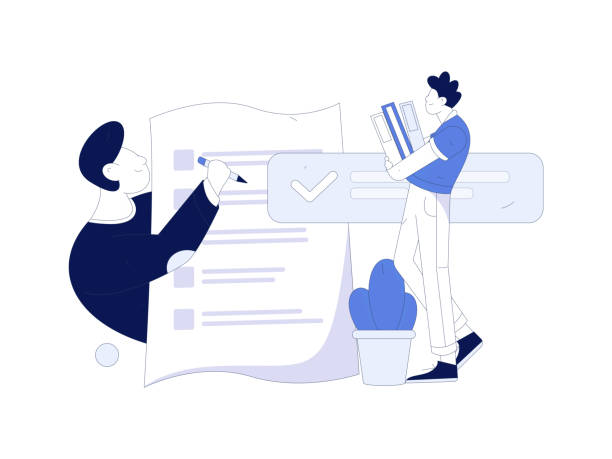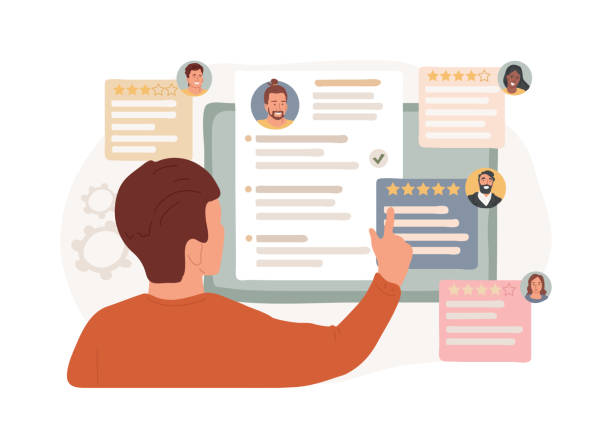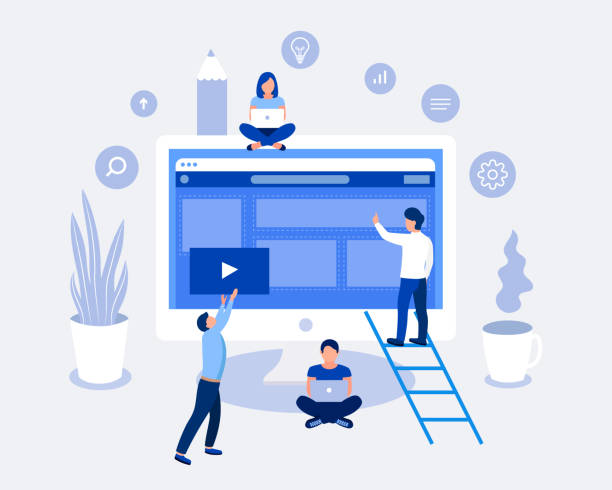Introduction to SEO-Optimized Website Design and Its Importance

In today’s digital world, having a website is just the first step.
What truly matters is the visibility of this website among billions of other pages.
This is where #SEO_Website_Design and the concept of #Search_Engine_Optimization (#SEO) come into play.
An SEO-optimized website is designed to be more understandable and appealing to search engines like Google, Bing, and Yahoo, by adhering to specific principles and rules.
This not only helps search engines better understand your site’s content but also sends them signals indicating your site’s quality and credibility.
The importance of SEO-optimized website design becomes clear when we know that over 90% of web traffic comes through search engines.
Therefore, if your site does not appear in the initial search results, you will practically lose a large portion of your potential audience.
The main goal of SEO is to increase #online_visibility and attract organic (free) and targeted traffic to the website.
This process includes technical, content, and backlink aspects, all working hand-in-hand to improve your site’s ranking.
This is not just a marketing technique but a long-term investment for the survival and growth of your online business.
A deep understanding of how search engines work and how to align your website with their expectations is the key to success in this field.
SEO is not just about using keywords; it also involves creating an exceptional user experience, organized structure, high speed, and valuable content for users.
Did you know that a poor corporate website costs you many opportunities daily? Solve this problem forever with professional corporate website design by Rasawob!
✅ Create a powerful and trustworthy image for your brand
✅ Targeted attraction of new customers and increased sales
⚡ [Get Free Website Design Consultation]
Keywords: The Beating Heart of SEO

One of the main and vital pillars in any website optimization with an SEO approach is the correct finding and use of keywords.
Keywords are phrases that users type into search engines to find the information, products, or services they need.
Choosing the right keywords is like setting the course for your entire SEO strategy.
If the wrong keywords are chosen, even with the best efforts in other areas, relevant traffic will not come to your website.
The keyword research process involves identifying phrases your target audience uses, analyzing their monthly search volume, and examining the level of competition for each word.
Tools such as Google Keyword Planner, Ahrefs, and Semrush are very helpful in this regard.
After identifying primary keywords, you should also look for LSI (Latent Semantic Indexing) keywords and Long-tail Keywords.
Long-tail keywords are longer phrases that have lower search volume but more accurately indicate user intent and typically have higher conversion rates.
For example, instead of “shoes”, you can use “best sports shoes for winter running”.
These types of keywords are less competitive and attract the most targeted traffic.
Also, it’s important to naturally incorporate keywords into your content, titles, meta descriptions, and URLs, and avoid keyword stuffing, which is penalized by Google.
Finally, periodic analysis of keywords and adapting them to changes in user behavior and Google’s algorithms is essential. This ensures that your strategy remains relevant and effective.
Information Architecture and URL Structure

The structure of a website, like the map of a city, plays a vital role in SEO-focused website design and user experience.
A strong and organized information architecture not only helps users navigate your site easily but also allows search engine bots to effectively crawl and index your content.
A hierarchical and logical structure, with clear categories and relevant subcategories, is highly desirable for SEO.
One important principle in this regard is the “three-click rule”; meaning a user should be able to access any page on the site with a maximum of three clicks.
| Principle | Explanation | SEO Impact |
|---|---|---|
| Hierarchical Organization | Content should be categorized from general to specific (Home > Category > Subcategory > Product). | Helps bots understand the relationship between pages and discover content. |
| Strong Internal Linking | Linking related pages to each other within the site. | Distributes PageRank (page authority), improves user experience, and enables deeper crawling. |
| Use of Breadcrumbs | Shows the user’s path on the site (Example: Home > Products > Apparel). | Improves navigation, reduces bounce rate, and assists search engines. |
| XML Sitemap | A file that specifies the complete site structure for search engines. | Ensures discovery and indexing of all important pages. |
Furthermore, URL structures play a significant role in SEO.
An SEO-friendly URL should be short, readable, and include keywords relevant to the page’s content.
Avoid special characters, meaningless numbers, and complex parameters in your URLs.
For example, instead of yoursite.com/?p=123&cat=4, use yoursite.com/blog/best-seo-articles.
Clean and meaningful URLs are more understandable for both users and search engines and can help improve your ranking. These practices are an essential part of a comprehensive and optimized website design for search engines.
SEO-Oriented Content Creation: The Secret to Audience Attraction

Content is king; this phrase clearly holds true in the world of SEO.
Producing high-quality, SEO-oriented content is the foundation of attracting an audience and the success of any SEO-optimized website design.
Your content must not only be optimized for search engines but, more importantly, it must create value for users and address their needs.
Content that provides accurate, comprehensive, and unique information typically achieves better results.
To produce SEO-oriented content, you must first identify appropriate keywords and then create rich and engaging content around those words.
This content can include blog articles, product pages, comprehensive guides, videos, infographics, and any other format that appeals to your audience.
Content length also matters; longer and more in-depth content (usually over 1000 words) often ranks better, as it indicates more comprehensive coverage of the topic.
However, quality precedes quantity.
Your content must be original, and you should avoid plagiarism. Using appealing headings (H1, H2, H3, etc.), short paragraphs, bullet points, and relevant images enhances content readability and appeal, and improves the user experience.
Also, it is important to regularly update your content to keep it fresh and relevant.
Search engines favor fresh content and give it a higher ranking.
Content SEO is not just about keyword inclusion, but about understanding user intent, providing comprehensive answers, and creating content that encourages sharing and keeps users on your site for extended periods.
Tired of losing customers due to poor e-commerce website design? With Rasawob, solve this problem forever!
✅ Increase sales and visitor-to-customer conversion rates
✅ Smooth and appealing user experience for your customers⚡ Get Free Consultation
Image Optimization and Website Loading Speed

Website loading speed and image optimization are two crucial yet often overlooked factors in website SEO that directly impact user experience (UX) and SEO ranking.
No one likes to wait long for a web page to load; studies have shown that even a one-second delay can lead to a decrease in conversion rates and an increase in bounce rate.
Search engines also consider site speed as a ranking factor.
There are several solutions to improve site speed: compressing images without losing quality, using browser caching, utilizing Content Delivery Networks (CDNs), optimizing codes (CSS, JavaScript, HTML), and choosing a reliable and fast hosting provider.
Regarding images, they can constitute a significant portion of a page’s size, which is why they must be carefully optimized.
To optimize images, use appropriate formats (such as WebP, which offers more compression), compress them with online tools or plugins, and determine the correct image dimensions before uploading. Furthermore, using ALT tags (Alt Text) for images is of high importance.
Alt Text is a text description of the image content that helps search engines understand the image and display it in image search results.
These descriptions are also crucial for users with visual impairments who use screen readers.
Also, choose image file names that include relevant keywords.
Tools like Google PageSpeed Insights and GTmetrix can help you analyze site speed and provide suggestions for improvement.
By following these tips, you will not only enhance your site’s user experience but also significantly contribute to improving your site’s ranking in search engines, which is an inseparable part of any successful SEO strategy.
User Experience (UX) and Its Impact on SEO

In recent years, Google has increasingly emphasized the importance of User Experience (UX) in website ranking.
This emphasis is such that it can be said UX is no longer a separate factor but an integral part of SEO-optimized website design principles. An excellent user experience encourages users to stay longer on your site, visit more pages, and perform desired actions (such as purchasing or signing up).
This positive interaction sends positive signals to search engines, indicating that your site is useful and valuable to users.
Google’s Core Web Vitals metrics, such as LCP (Largest Contentful Paint) for loading speed, FID (First Input Delay) for interactivity, and CLS (Cumulative Layout Shift) for visual stability, are examples of criteria Google considers for evaluating user experience and influencing site ranking.
A website with poor UX will have a high Bounce Rate, meaning users quickly leave the site.
This is a negative signal for search engines and can lead to a drop in ranking.
Furthermore, responsive design, which optimizes your site for correct display on various devices (mobile, tablet, desktop), is vital.
Given the increasing use of mobile for internet access, having a Mobile-Friendly website is no longer an option but a necessity.
Mobile-friendliness not only aids user experience but also directly impacts Google’s ranking.
Easy navigation, appealing visual design, appropriate content readability, and clear Calls-to-Action (CTAs) are all important elements that help improve UX and, consequently, SEO.
Investing in UX means investing in your SEO and overall online success.
Technical SEO: From Crawling to Indexing

Technical SEO refers to a set of actions taken to help search engines crawl, index, and understand your website.
This aspect of website optimization for search engines is more concerned with the site’s technical infrastructure than its content.
If your site’s technical section has issues, even with the best content, you might not succeed in ranking.
One of the first steps in technical SEO is ensuring the website’s crawlability.
This means search engine bots should be able to easily access and read all important pages on your site.
The robots.txt file, XML sitemap, and meta robots tags are tools used to control crawling.
The robots.txt file tells search engines which pages not to crawl (e.g., login pages or admin panels).
The XML sitemap provides search engines with a list of all important URLs on your site to ensure they are indexed.
| Technical Factor | Explanation | SEO Impact |
|---|---|---|
| SSL Certificate (HTTPS) | Encrypts communication between user and site for enhanced security. | Google ranking factor and user trust. |
| 404 Errors and Redirects | Checking for not-found pages and correct use of 301 redirects. | Preserves link authority and prevents negative user experience. |
| Structured Data (Schema Markup) | Adding special codes to help search engines understand content. | Displays Rich Snippets in search results (e.g., star ratings). |
| Canonical Tags | Specifying the original version of a page in case of duplicate content. | Prevents duplicate content issues and reduced authority. |
Also, ensure that your site functions without any errors, especially server errors (like 5xx) or user errors (like 4xx).
Tools like Google Search Console are essential for identifying and resolving these issues. Technical SEO is a dynamic field and requires continuous monitoring and updating to ensure your website is always optimized for search engines.
The Role of Backlinks and Domain Authority in SEO

Backlinks, or inbound links, are the backbone of off-page SEO and play a crucial role in determining the authority and ranking of an optimized website design.
A backlink is a link from another website to your website.
Search engines like Google consider backlinks as a “vote of confidence” from other websites.
The more and higher quality your backlinks, the more authoritative and trustworthy your site is perceived by search engines, and this helps improve your ranking.
However, not all backlinks are equal.
The quality of backlinks is far more important than their quantity. A backlink from a reputable, relevant, and high-authority site (such as a university, a credible news organization, or a well-known industry website) is worth far more than dozens of backlinks from low-quality or spammy sites.
Spammy or artificial links are not only worthless but can also lead to your site being penalized by Google.
Link Building strategy should focus on acquiring natural and high-quality backlinks.
This can be achieved through creating excellent content that is naturally linked by others, digital PR, guest blogging, and collaborating with influencers.
Also, it’s important to regularly check your backlink profile to identify malicious or spammy links and disavow them using Google’s Disavow Tool.
Domain Authority or Domain Rating is a metric that indicates the overall strength of a domain in SEO and is directly related to the quality of its backlinks.
The higher your domain authority, the greater your chances of ranking for competitive keywords.
Ultimately, backlinks represent your website’s credibility and authority in the eyes of search engines and are an indispensable part of achieving top SEO results.
Did you know that customers’ first impression of your company is your website? Multiply your business’s credibility with a powerful corporate website from Rasawob!
✅ Custom and captivating design tailored to your brand
✅ Improved user experience and increased customer attraction
⚡ Get free consultation!
Data Analysis and SEO Performance Monitoring

After implementing the SEO-optimized website design process, the work is not over.
SEO is an ongoing process, and to ensure the effectiveness of your strategies, you need continuous monitoring and data analysis.
Data analysis helps you understand your website’s performance in search engines, identify strengths and weaknesses, and discover new opportunities for improvement.
The main tools for monitoring SEO performance include: Google Analytics and Google Search Console.
Google Analytics provides precise information about user behavior on your site, including the number of visitors, pages visited, time spent, bounce rate, traffic sources (organic search, social media, referral, etc.), and user demographic information.
By analyzing this data, you can understand user behavior patterns and optimize your content for their needs.
Google Search Console (GSC) is a tool specifically provided by Google for webmasters to monitor their site’s SEO performance directly from Google’s perspective.
GSC displays information such as the keywords your site appears for in searches, the average ranking for each keyword, the number of clicks and impressions, crawl errors, indexing issues, and backlinks.
This information is vital for identifying technical SEO issues, monitoring site health, and understanding how Google interacts with your site.
Additionally, paid SEO tools like Ahrefs, Semrush, and Moz offer more advanced analytical capabilities, including competitor analysis, deeper keyword research, and backlink monitoring.
Regular monitoring and analysis allow you to observe Google’s algorithm reactions, understand market changes, and dynamically adjust your SEO strategy.
Without data, SEO is like driving with your eyes closed; therefore, precise analysis and monitoring are an indispensable part of any successful SEO campaign.
The Future of SEO-Optimized Website Design and Emerging Trends

The world of SEO never stands still and is constantly evolving.
Search engine algorithms are continuously updated, and new trends emerge that change the requirements for the future of SEO-optimized website design.
Understanding these changes and anticipating future trends is essential to maintain an edge in online competition.
One of the most important current and future trends is the growing importance of User Intent. Search engines pay attention not only to keywords but also to the purpose behind the user’s search (informational, commercial, navigational).
Creating content that fully addresses user intent is the key to future success.
Voice search is also on the rise and affects how keywords are optimized.
Users in voice search employ more natural language and longer phrases, which means greater importance for long-tail keywords and conversational content.
Also, Artificial Intelligence (AI) plays an increasing role in SEO; from understanding content and user intent (like Google’s BERT and RankBrain algorithms) to content generation tools and data analysis.
It is expected that AI will completely revolutionize interaction with search engines in the future.
E-A-T (Expertise, Authoritativeness, Trustworthiness) will also remain a vital factor.
Google gives higher rankings to sites whose content is prepared by experts, are authoritative, and trustworthy.
This means a greater emphasis on the author’s credibility and the source of information.
Designing a website with a focus on these principles and preparing for new technologies like visual search and augmented reality can help you stay ahead of changes.
The future of SEO is moving towards more personalized user experiences, richer multimedia content, and a deeper understanding of human intent.
Understanding and adapting to these trends will prepare you for success in the future online arena.
Frequently Asked Questions
| Question | Answer |
|---|---|
| What is SEO-optimized website design? | SEO-optimized website design means designing and coding a website that is technically, content-wise, and structurally optimized so that search engines can easily crawl and index it, and assign it a higher rank in search results. |
| Why is SEO-optimized website design important? | Its importance lies in increasing website visibility in search engine results (like Google), attracting more organic traffic, improving user experience, and ultimately increasing conversion rates (sales or desired actions). |
| What are the most important technical SEO factors in website design? | High loading speed, responsiveness (Mobile-Friendly), proper URL structure, use of SSL certificate (HTTPS), XML sitemap, and robots.txt file. |
| What is the impact of responsiveness (Responsive Design) on SEO? | Since most searches are conducted via mobile, Google prioritizes responsive websites. Responsive design improves user experience and reduces bounce rate, both of which help SEO. |
| How does website loading speed affect SEO? | Loading speed is an important ranking factor for Google. Slow websites lead to poor user experience, increased bounce rate, and lower rankings in search results. |
| What is the role of URL structure in SEO? | Short, readable URLs that include relevant keywords help both users and search engines better understand the page’s topic, and this positively impacts SEO. |
| What is the importance of using Title Tags and Meta Descriptions in SEO design? | These tags provide information about the page’s content to search engines and users. Optimizing them with appropriate keywords increases click-through rate (CTR) and improves content understanding by search bots. |
| What is the importance of Image Optimization in SEO? | Reducing image size to increase site speed, using descriptive Alt text (including keywords) to describe the image to search engines, and increasing the chance of appearance in Google Image Search. |
| How does Internal Linking help SEO? | Internal linking helps search engines better understand the site’s structure, distributes authority (PageRank) throughout the site, and directs users to related pages, which improves user experience and reduces bounce rate. |
| What is the relationship between User Experience (UX) and SEO? | Google values websites that provide a good user experience. Appealing visual design, easy navigation, readable content, and high speed all contribute to improved UX, which in turn leads to reduced bounce rate, increased time on site, and positive signals to search engines. |
And other services of Rasa Web Advertising Agency in the field of advertising
Smart Sales Automation: A fast and efficient solution for increasing click-through rates, focusing on attractive user interface design.
Smart Advertising Campaign: A dedicated service for growth and SEO ranking improvement based on precise audience targeting.
Smart Customer Journey Map: An effective tool for SEO ranking improvement through SEO-oriented content strategy.
Smart Custom Software: A combination of creativity and technology for analyzing customer behavior through user experience customization.
Smart SEO: A dedicated service for growth and SEO ranking improvement based on marketing automation.
And over a hundred other services in the field of internet advertising, advertising consultation, and organizational solutions
Internet Advertising | Advertising Strategy | Advertorials
Sources
Comprehensive Guide to SEO-Optimized Website DesignPrinciples of SEO-Friendly Website DesignSEO in Website Design: Key TipsHow to Design a Successful SEO-Optimized Website?
🚀 For your business to soar in the digital world and reach the pinnacle of success, Rasawob Afarin Digital Marketing Agency is by your side with innovative services including modern UI website design, SEO, and advertising campaign management, to ensure a powerful and lasting online presence.
📍 Tehran, Mirdamad Street, next to Central Bank, Kazeroon Southern Alley, Ramin Alley, No. 6


